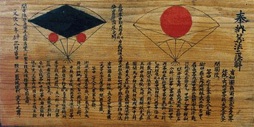Spherical and Hyperbolic Geometry
Summer 2022
Since coming to GVSU I have been involved in conducting research with undergraduates. I have mentored many summer projects resulting in several publications and awards for my students. Below is a description of one of my projects for Summer 2022. This project continues the process started by my students in the early 2000s and continued by students in projects from 2018 and 2019.
Overview and Introduction
The main purpose of this project is to generalize results from Euclidean geometry into spherical and hyperbolic geometry. The hope is to create new unified results that can be easily expressed in all three of these geometries. As the goal of this project is to create new spherical and hyperbolic results from Euclidean ones, we must start with Euclidean results that have not already been generalized.
Japanese temple problems are ancient Euclidean geometry problems that were inscribed on colorful tablets (Sangaku) and hung as a form of worship in temples across Japan during the Edo period (1603-1867). See the two examples above. Sangaku theorems involve arrangements of lines, circles, triangles, squares, pentagons, and often ellipses (which are regarded as a planar section of a right circular cylinder), but sometimes involved spheres. The Edo period marked a time when Japan was an isolated country relatively closed off from western influences and ideas. During this time they developed their own mathematics (Wasan) independent of the West. Several western theorems (like Soddy's Hexlet and Malfatti Theorem) were proved by Japanese mathematicians prior to their “discovery” in the West.
This project is a continuation of one from summer 2004, 2018, and 2019. Over each of those summers I worked with two students to extend some results from Wasan to spherical and hyperbolic geometry. As many of these problems involved ellipses, we first had to understand what ellipses were on the surface of the sphere. We were very successful in characterizing ellipses (using the definition of the sum of the distances from two foci is constant) on the surface of the sphere and later in the hyperbolic plane. This allowed us to generalize a Japanese temple problem that we called the flower problem on the sphere and in the hyperbolic plane. This is pictured below.
In Western society, the roots of spherical geometry extend back to Greek antiquity. Euler (1707-1783) published a collection of papers devoted to spherical geometry and by the 1800s there were many textbooks for use in college classes. (Among them is Isaac Todhunter's Spherical Trigonometry published in at least five editions from 1859-1886.) It appears that spherical geometry was most widely studied by Western mathematicans in the the mid 1800 which is also around the time of the discovery of hyperbolic geometry by Gauss, Bolyai and Lobachevsky. By the mid 1900s classes on spherical geometry and trigonometry had all but vanished from the collegiate curriculum and hyperbolic geometry had been generalized to Reimannian geometry. This means that to find Euclidean results that may have not been generalized into we must either study results from the past 50 years or another source of problems that weren't accessible to Mathematicians in the West.

